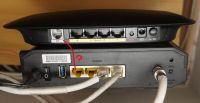Homies,
I have a Cisco EPC3825 Cable Modem provided by my Toya service provider. A coaxial cable enters it. It has Wifi and ethernet sockets. Devices connected to the modem get addresses from DHCP, the IP of the modem itself also changes over time.
Problem:
Although each of the devices at home connects to the Internet, I have problems with communicating them with each other. After days of searching the net and experimenting, I've come to the conclusion that each of my devices gets an address on a different subnet, and apparently this is a hindrance to most of the things I'm trying to achieve. The ability to configure this hardware from Toya is blocked.
Is it possible, however, without buying additional equipment, to make the devices receive addresses from one subnet?
I tried to deal with the problem with the router from my previous apartment - the Linksys wag120n - but to no avail. I read in another thread ( Link ) that this equipment cannot connect more than a single device, but I don't really understand why. I know that there are threads on the forum in which people recommend specific models, but I want to know which parameter is responsible for that?
In response to the cited topic @bogiebog wrote that it must be an "ethernet modem" - then you can find out that something is an "ethernet modem" because usually in product descriptions this phrase is not used?
ADDITIONAL INFORMATION
The only way that the user (at least officially) can interfere with the configuration is to change the channel, signal strength and turn on and off wifi in the client panel on Toya's website.
I found the address of the modem's configuration panel, but the login details are not factory-set and I could not guess.
I try to create a network in which:
- all devices will see NAS (WD MyCloud). The main computer and NAS would be wired to the modem.
- Android devices (and not only), will be able to receive streams (remote control for gaming, among others) from the main PC using applications such as: Moonlight, Remotr, KinoConsole / KinoRemote.
- devices will see each other in network neighborhood. Mainly it is about devices with windows, but also various other OSes. (not necessary, but probably not a problem at this stage?)
I have a Cisco EPC3825 Cable Modem provided by my Toya service provider. A coaxial cable enters it. It has Wifi and ethernet sockets. Devices connected to the modem get addresses from DHCP, the IP of the modem itself also changes over time.
Problem:
Although each of the devices at home connects to the Internet, I have problems with communicating them with each other. After days of searching the net and experimenting, I've come to the conclusion that each of my devices gets an address on a different subnet, and apparently this is a hindrance to most of the things I'm trying to achieve. The ability to configure this hardware from Toya is blocked.
Is it possible, however, without buying additional equipment, to make the devices receive addresses from one subnet?
I tried to deal with the problem with the router from my previous apartment - the Linksys wag120n - but to no avail. I read in another thread ( Link ) that this equipment cannot connect more than a single device, but I don't really understand why. I know that there are threads on the forum in which people recommend specific models, but I want to know which parameter is responsible for that?
In response to the cited topic @bogiebog wrote that it must be an "ethernet modem" - then you can find out that something is an "ethernet modem" because usually in product descriptions this phrase is not used?
ADDITIONAL INFORMATION
The only way that the user (at least officially) can interfere with the configuration is to change the channel, signal strength and turn on and off wifi in the client panel on Toya's website.
I found the address of the modem's configuration panel, but the login details are not factory-set and I could not guess.
I try to create a network in which:
- all devices will see NAS (WD MyCloud). The main computer and NAS would be wired to the modem.
- Android devices (and not only), will be able to receive streams (remote control for gaming, among others) from the main PC using applications such as: Moonlight, Remotr, KinoConsole / KinoRemote.
- devices will see each other in network neighborhood. Mainly it is about devices with windows, but also various other OSes. (not necessary, but probably not a problem at this stage?)



